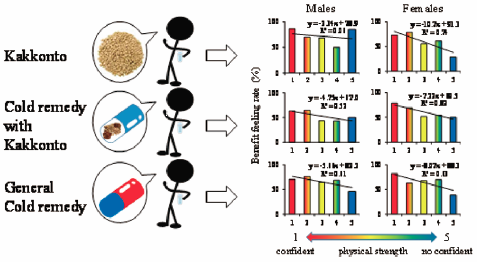- 著者
- Mitsuyoshi Okita Yuki Yayoshi Kousuke Ohara Akio Negishi Hayato Akimoto Naoko Inoue Sachihiko Numajiri Shigeru Ohshima Seiichi Honma Shinji Oshima Daisuke Kobayashi
- 出版者
- The Pharmaceutical Society of Japan
- 雑誌
- Biological and Pharmaceutical Bulletin (ISSN:09186158)
- 巻号頁・発行日
- vol.40, no.10, pp.1730-1738, 2017-10-01 (Released:2017-10-01)
- 参考文献数
- 21
- 被引用文献数
- 3
Kakkonto (KK), a traditional Japanese Kampo formulation for cold and flu, is generally sold as an OTC pharmaceuticals used for self-medication. Kampo formulations should be used according to the Sho-symptoms of Kampo medicine. These symptoms refer to the subjective symptoms themselves. Although with OTC pharmaceuticals, this is often not the case. We surveyed the relationship of agreement of Sho with the benefit feeling rate (BFR) of patients who took KK (n=555), cold remedies with KK (CK, n=315), and general cold remedies (GC, n=539) using internet research. BFR of a faster recovery was greater in participants who took the medication early and who had confidence in their physical strength in all treatment groups. BFR was significantly higher in the GC group than in the KK group for patients with headache, runny nose, blocked nose, sneezing, and cough. BFR was also significantly higher in the GC group than in the CK group for headache (males) and cough (females). BFR was the highest in the KK group for stiff shoulders. All cold remedies were more effective when taken early, and the larger the number of Sho that a patient had, the greater the BFR increased. Therefore, a cold remedy is expected to be most effective when there are many cold symptoms and when it is taken at an early stage of the common cold.
- 著者
- Mitsuyoshi Okita Yuki Yayoshi Kousuke Ohara Akio Negishi Hayato Akimoto Naoko Inoue Sachihiko Numajiri Shigeru Ohshima Seiichi Honma Shinji Oshima Daisuke Kobayashi
- 出版者
- 公益社団法人日本薬学会
- 雑誌
- Biological and Pharmaceutical Bulletin (ISSN:09186158)
- 巻号頁・発行日
- pp.b17-00340, (Released:2017-08-04)
- 参考文献数
- 21
- 被引用文献数
- 3
Kakkonto (KK), a traditional Japanese Kampo formulation for cold and flu, is generally sold as an over-the-counter (OTC) pharmaceuticals used for self-medication. Kampo formulations should be used according to the Sho-symptoms of Kampo medicine. These symptoms refer to the subjective symptoms themselves. Although with OTC pharmaceuticals, this is often not the case. We surveyed the relationship of agreement of Sho with the benefit feeling rate (BFR) of patients who took KK (n = 555), cold remedies with KK (CK, n = 315), and general cold remedies (GC, n = 539) using internet research. BFR of a faster recovery was greater in participants who took the medication early and who had confidence in their physical strength in all treatment groups. BFR was significantly higher in the GC group than in the KK group for patients with headache, runny nose, blocked nose, sneezing, and cough. BFR was also significantly higher in the GC group than in the CK group for headache (males) and cough (females). BFR was the highest in the KK group for stiff shoulders. All cold remedies were more effective when taken early, and the larger the number of Sho that a patient had, the greater the BFR increased. Therefore, a cold remedy is expected to be most effective when there are many cold symptoms and when it is taken at an early stage of the common cold.
